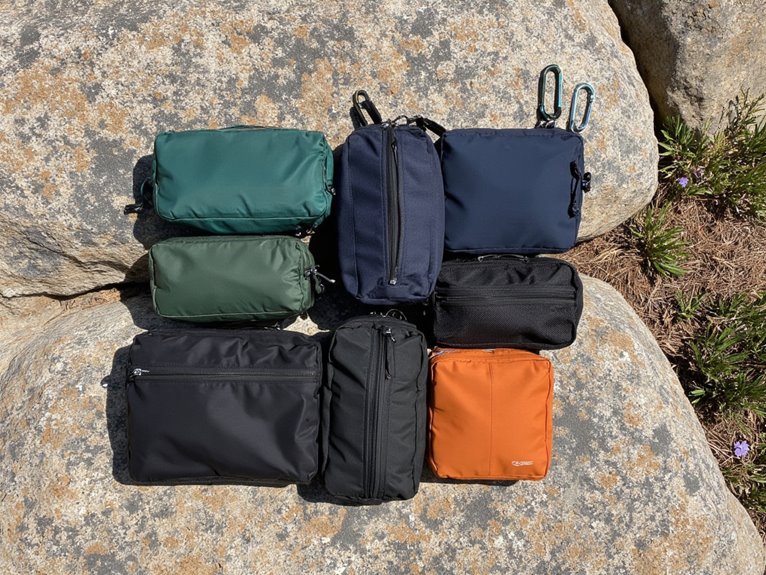Are Packrafts Stable?
Packrafts are indeed stable, and their stability is attributed to a combination of design features, proper inflation, and well-balanced buoyancy. A well-designed hull shape, comfortable seating position, and adjustable footrests all contribute to a secure ride. Proper inflation is vital, with the sweet spot between 1.5 and 2.5 PSI, depending on the manufacturer's recommendations. And in rough waters, packrafts have proven to be agile and responsive, with a nimble feel perfect for maneuvering tight spaces. So, buckle up and get ready to take on the water – there's more to discover regarding packraft stability.
We are supported by our audience. When you purchase through links on our site, we may earn an affiliate commission, at no extra cost for you. Learn more. Last update on 14th December 2025 / Images from Amazon Product Advertising API.
Design Features for Stability
Incorporating specific design features is essential to achieving stability in packrafts, as they can profoundly impact the boat's performance and safety on the water.
A stable packraft is not just about looking cool; it's about staying upright and in control.
One key design feature is a rounded hull shape, which helps to deflect waves and maintain stability.
Another essential aspect is the seating position, which should allow the paddler to sit comfortably with their feet stretched out in front of them, providing balance and control.
Additionally, a well-designed skeg can help track straight and prevent the packraft from fishtailing.
Inflated Pressure and Stability
Riding the fine line between a soft, squishy ride and a taut, responsive one, the ideal inflated pressure is crucial for maintaining stability in a packraft.
Under-inflated, and you'll be wallowing in the water like a lazy hippo; over-inflated, and you'll be bouncing around like a hyperactive kangaroo. Neither scenario is ideal for stability.
The sweet spot is where the packraft feels firm, but not rigid, allowing it to absorb bumps and waves while maintaining its shape.
Generally, this translates to an inflation pressure between 1.5 and 2.5 PSI, depending on the manufacturer's recommendations and your personal preference.
Hull Shape and Buoyancy
While a well-inflated packraft is essential for stability, its hull shape and buoyancy also play a significant role in keeping you upright and on course, especially when traversing choppy waters or steering tight turns.
A well-designed hull shape can greatly impact a packraft's stability, making it more resistant to tipping or capsizing.
Buoyancy, on the other hand, affects how the packraft interacts with the water, influencing its responsiveness and maneuverability.
A packraft with adequate buoyancy will be more responsive to paddle inputs, making it easier to steer and control.
Cockpit and Seat Design
Every packrafter knows that a well-designed cockpit and seat can make all the difference between a comfortable, confidence-boosting ride and a frustrating, back-busting struggle to stay upright.
A well-contoured cockpit provides a snug, secure fit, keeping you connected to the boat and allowing for precise control. A supportive seat, meanwhile, helps maintain good posture and reduces fatigue.
Look for features like adjustable footrests, ergonomic seating, and strategically placed thigh straps to boost stability and comfort.
A poorly designed cockpit, on the other hand, can lead to a wobbly, unconfident ride – and who wants that?
Stability in Calm Waters
In calm waters, a packraft's stability is largely determined by its hull design and volume distribution, which can make all the difference between a serene, effortless paddle and a tippy, anxiety-inducing struggle to stay upright.
A well-designed hull will provide a stable platform, allowing you to focus on the scenery rather than clinging to the sides for dear life.
Look for a packraft with a rounded hull and a balanced volume distribution, which will help it track straight and resist tipping.
Additionally, a lower seat position can also improve stability, making it easier to paddle and maneuver.
Handling Choppy Water Conditions
When the water gets rough, a packraft's stability is put to the test, and its ability to handle choppy conditions becomes a critical factor in ensuring a safe and enjoyable ride.
In choppy waters, a packraft's stability is put to the test, and its ability to handle choppy conditions becomes paramount.
The good news is that modern packrafts are designed to handle rough waters with ease.
Their lightweight and compact design allows them to cut through waves with agility, while their flexible hulls absorb shock and maintain stability.
With proper paddling techniques and a bit of practice, you'll be traversing choppy waters like a pro in no time.
Comparing Stability to Kayaks
In terms of stability, packrafts and kayaks have some key differences that set them apart.
One major distinction lies in their width, with kayaks typically being narrower and packrafts being wider, which has a significant impact on their stability in the water.
This design difference affects their stability, and that has implications for paddlers.
Width and Stability
A wider packraft is not always a more stable one, a misconception that stems from comparing packrafts to kayaks, which often prioritize width as a key factor in stability.
In fact, a wider packraft can be more prone to tipping due to its higher center of gravity.
This is because packrafts are designed for shallow water and portability, not for open ocean or whitewater use like kayaks.
A narrower packraft, on the other hand, can be more stable due to its lower center of gravity and reduced wind resistance.
It's essential to weigh the specific design and purpose of a packraft when evaluating its stability.
Primary Vs Secondary
The kayak-packeraft stability analogy is a classic case of comparing apples and oranges, with the latter often getting a bad rap due to unrealistic expectations.
Kayaks, with their sleek hulls and narrow profiles, are designed for speed and agility, whereas packrafts prioritize portability and versatility.
When evaluating stability, it's essential to distinguish between primary and secondary stability.
Primary stability refers to a boat's initial resistance to tilting, whereas secondary stability involves its ability to recover from an upset.
Kayaks excel in primary stability, but packrafts often outshine them in secondary stability, thanks to their robust, forgiving designs.
Real-World User Experience
Now that we've delved into the theoretical aspects of packraft stability, it's time to get real – literally.
We're shifting our focus to the real-world user experience, where the rubber meets the road (or rather, the water).
In this section, we'll examine the on-water performance tests, everyday use impressions, and white water experiences that give us a true sense of packraft stability in action.
On-Water Performance Tests
Packrafts are surprisingly agile and responsive, with a nimble feel that's perfect for maneuvering tight spaces.
However, they do have a few quirks – like a tendency to spin out in strong currents – that require some getting used to.
Overall, packrafts are stable enough for beginners, but still offer plenty of excitement for experienced paddlers.
Just remember to keep your weight centered, and you'll be gliding across the water like a pro in no time!
In our on-water performance tests, we put these tiny boats to the test, pushing them to their limits in various conditions.
Everyday Use Impressions
Across hundreds of miles and countless rivers, packraft enthusiasts have logged thousands of hours of real-world experience, providing a wealth of insight into the everyday use and practicality of these versatile boats.
In everyday use, packrafts have proven to be surprisingly stable, even for novice paddlers.
Packrafts have proven to be incredibly responsive, making them a joy to paddle in tight spaces.
The ergonomic design and adjustable seats guarantee a comfortable ride, even on long trips.
Despite their lightweight construction, packrafts have proven to be remarkably resilient in the face of rough handling and harsh environments.
The ability to stash a packraft in a backpack and hike to remote waters has opened up a world of possibilities for adventurous paddlers, allowing them to confirm a convenient and flexible paddling experience.
White Water Experiences
What makes packrafts truly shine is their ability to handle the rough stuff, with users consistently reporting that these tiny boats can hold their own in surprisingly turbulent whitewater.
In fact, many enthusiasts swear that packrafts are more stable in whitewater than traditional kayaks or canoes.
This is largely due to their buoyant and flexible design, which allows them to absorb shocks and bumps with ease.
Real-world users rave about their packrafts' ability to navigate Class III rapids with ease, and some have even tackled Class IV waters with success.
While they may not be the most agile or responsive, packrafts have proven themselves to be capable and trustworthy companions in the midst of chaotic whitewater.


